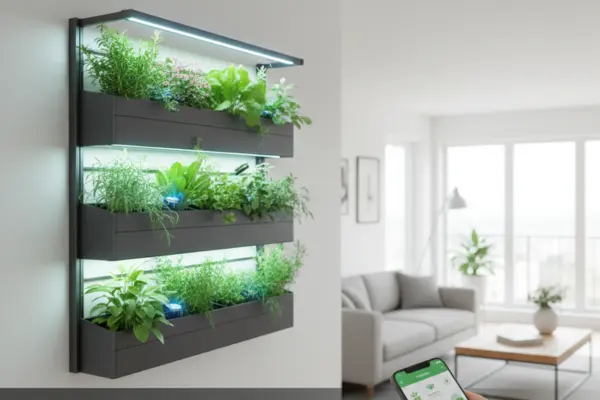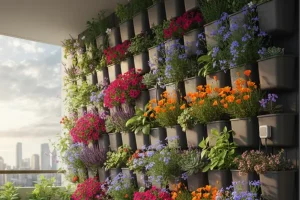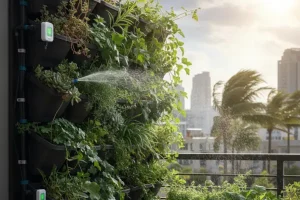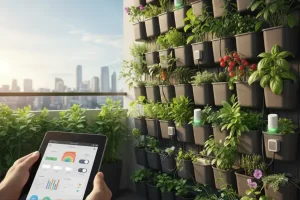Vertical gardens already make it easier to grow food in small spaces, but what if you could take it one step further? Imagine your plants telling you when they’re thirsty, when they need more nutrients, or when the temperature is too hot. Thanks to modern smart garden technology, this is no longer science fiction—it’s reality.
By integrating sensors and apps into your vertical garden, you can monitor plant health, automate care, and make gardening easier than ever before. Whether you’re a busy professional or a beginner who wants reliable results, upgrading to a smart vertical garden can transform your growing experience.
Why Go Smart?
Smart garden technology isn’t just about convenience. It helps you:
- Reduce guesswork in watering and feeding
- Prevent plant stress with real-time alerts
- Save time with automation
- Track your garden’s progress over weeks and months
- Achieve better yields with consistent care
For apartment gardeners or anyone managing multiple plants, smart features take the stress out of daily maintenance.
Key Smart Features to Consider
1. Moisture Sensors
These sensors measure soil or growing medium moisture levels and notify you when water is needed. In hydroponic vertical systems, they track water flow and prevent dry spots.
Benefit: Eliminates overwatering or underwatering.
2. Light Sensors
Measure how much light your plants receive throughout the day. Perfect for indoor setups where natural light may not be enough.
Benefit: Helps you know when to add or adjust grow lights.
3. Temperature & Humidity Sensors
These keep track of the microclimate around your plants. Vertical gardens near windows or outdoors often experience fluctuating temperatures.
Benefit: Protects plants from stress due to heat waves, drafts, or cold snaps.
4. pH and EC Sensors (for Hydroponics)
pH sensors ensure nutrient solutions stay in the right range, while EC (electrical conductivity) sensors measure nutrient concentration.
Benefit: Keeps water chemistry balanced for strong, healthy growth.
5. Smart Watering Systems
Combine pumps, tubing, and timers with sensors that automatically adjust watering based on plant needs.
Benefit: Reduces daily manual watering.
6. App Integration
Most smart systems connect to apps on your smartphone. Apps provide:
- Real-time notifications
- Data tracking over time
- Remote control of pumps, lights, and fans
- Integration with smart home systems (Alexa, Google Home)
Step-by-Step Guide to Upgrading
- Choose Your Base System
- Soil-based vertical wall? Start with moisture and light sensors.
- Hydroponic tower? Add pH, EC, and pump automation.
- Soil-based vertical wall? Start with moisture and light sensors.
- Select Compatible Sensors
Look for Wi-Fi or Bluetooth-enabled sensors that connect to your smartphone. - Install Automation Tools
Add smart timers for pumps, smart plugs for lights, and nutrient dosing machines if hydroponic. - Connect to an App
Download the manufacturer’s app, sync your devices, and set up notifications. - Test & Adjust
Monitor your garden for a week. Adjust settings until plants respond well.
Sample Smart Setup for Beginners (Approx. $150–$250)
| Component | Approximate Cost | Purpose |
| Moisture sensor (Wi-Fi) | $20–$30 | Tracks watering needs |
| Light sensor | $25–$40 | Measures indoor light levels |
| Smart timer for pump/lights | $30–$50 | Automates schedules |
| App-enabled pH/EC monitor | $60–$100 | Monitors hydroponic nutrients |
| Grow light with smart plug | $40–$60 | Provides consistent light |
Common Mistakes to Avoid
- Buying Too Many Gadgets at Once
Start with the basics (moisture sensor and smart timer). Add more as you get comfortable. - Ignoring Calibration
Sensors need calibration to give accurate readings. Follow manufacturer instructions carefully. - Relying Only on Tech
Smart tools help, but they don’t replace observing your plants. Use data as guidance, not the only source. - Not Checking Connectivity
Some sensors require strong Wi-Fi or Bluetooth. Make sure your setup works in your chosen garden spot.
FAQs
Q: Do I need Wi-Fi to use smart garden sensors?
Most require Wi-Fi for full app functionality, but some use Bluetooth for short-range connections.
Q: Can I use smart features with soil-based vertical gardens?
Yes. Moisture and light sensors are especially helpful for soil systems.
Q: Are smart gardens expensive to maintain?
After the initial investment, most sensors and apps require little ongoing cost. Some premium apps may charge small subscription fees.
Q: What happens if my Wi-Fi goes out?
Most smart timers and pumps continue working on their last programmed schedule until connectivity is restored.
Next Steps & Related Reading
If you’re just starting out with automation, read Automating Your Vertical Garden: Timers, Pumps & Controllers for a step-by-step beginner setup.
Ready to expand your growing area? See How to Scale Your Vertical Farming System from Balcony to Backyard for tips on managing larger spaces with smart technology.
Conclusion
Upgrading to a smart vertical garden doesn’t have to be complicated or expensive. By starting with a few basic sensors and app integrations, you can take the guesswork out of plant care, ensure consistent growth, and save valuable time.
As you expand your system, more advanced features like nutrient monitoring and full automation can help you run a high-tech garden with minimal effort.
Would you upgrade your vertical garden with sensors first, or jump straight into full automation with app controls?




